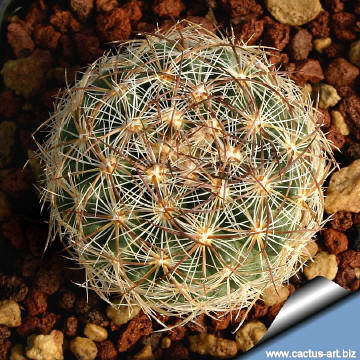|
|
|

Pediocactus simpsonii is an extremely hardy and very variable ball
cactus of mountains and prairies of north America, the spines almost
completely obscure the stems.
|
|
Description: Generally singular but occasionally forming small
clusters. This plant is an exceedingly variable species. a bit of
variation throughout its range and some taxonomists recognize several
varieties. The segregation of the many forms, varieties, and subspecies
on the basis of morphology, however, is difficult to support, given the
continuous range of variation in stem size and flower color over its
geographic range.
Stems: Depressed-ovoid to ovoid or globular stems that are
2.5-15(-25) tall × 2.5-15 cm in diameter.
Areoles: circular to oval, villous.
Tubercles: Spirally arranged, conicalabout 5 to 15 mm long.
Spines: Located on the tips of the tubercles smooth, relatively
hard, distinguishable as radial and central.
Radials: 15 to 35 widely spreading, white, slender, which are
3-13 mm long.
Centrals: 4 to 11 widely spreading about 1 to 2 cm long reddish
brown (rarely black) with basal half cream or yellow, rigid, straight or
slightly curved. Sometimes the spines almost obscure the surface of the
plant.
Flowers: 2 to 2,5 cm, bell shaped with scales and outer tepals
minutely toothed and laciniate or entire and often undulate; ranging
from magenta, pink, straw-yellow, to whitish outer tepals with greenish
brown midstripes. The buds and flowers originate in a small circle at
the apex of the plant.
Blooming season: Open from mid April on into May. The flowers
usually remain closed on cloudy days.
Fruits: Almost spherical to short cylindric 6-11 × 5-10 mm ,
green at first, turning tan, drying reddish brown and splitting along
the side when mature.
Seeds: Gray to black, 2-3 × 1.5-2 mm, papillate but not rugose.
|
|
 |
 |
|


Advertising
|
|
|
|
|
Family:
Cactaceae (Cactus
Family)
Scientific name:
Pediocactus simpsonii
(Engelm.) Britt. & Rose
Published in N. L. Britton and A. Brown, Ill. Fl. N.
U.S. ed. 2. 2: 570. 1913 (as simpsoni).
Origin: The species has the widest distribution of
any Pediocactus, and is found at the highest elevation. throughout much
of the mountain in west USA (Arizona., Colorado, Idaho, Montana.,
Nevada, New Mexico, South Dakota., Utah, Wyoming)
Habitat: Its preferred habitat is generally higher in
elevation and cooler and moister than most other cacti. This is one of
the most cold-hardy species and is found as high as 1400-3500 m. These
plants can be found growing in a variety of, prairie grassland, rocky
steppes, sagebrush, pinyon-juniper woodland, and montane coniferous
forest habitats. This cactus is frequently concealed under larger
vegetation and is frequently camouflaged under plant litter and grasses.
During winter dormancy it may actually shrink below the ground surface.
Interestingly, the flowers are generally pink on the eastern slope and
yellowish on the western slope plants.
Conservation status: Listed in
CITES appendix 2.
Common Names include: Mountain ball cactus,
Simpson’s footcactus, Simpon’s hedgehog cactus
Etymology: Named in honour to the army engineer James H. Simpson
who led an expedition in Colorado
Taxon
synonyms:
- Echinocactus simpsonii Engelmann,
Trans. Acad. St. Louis 2:197, 1863. (as simpsoni)
- Mammillaria simpsonii (Engelmann) Jones,
Zoe 3:302, 1893.
- Mammillaria purpusii (Engelmann) Schumann,
Monatsschr.Kakteenk. 4:165, 1894.
- Pediocactus hermannii Marshall, Saguaroland
Bull. 8:78, 1954.
- Pediocactus simpsonii (Engelmann) var.caespiticus
Backeberg,
Nat .Cact. & Succt. J. (GB), 14:63, 1959. nom. nud.,
Cactaceae, 5:2846 f. 2672 nom. inval.1961.
- Pediocactus simpsonii (Engelmann) var. hermannii
Wiegand & Backeberg,
Die Cactaceae 5:2846, 1961.
- Echinocactus simpsonii var. minor Engelmann;
- Echinocactus simpsonii var. robustior J. M. Coulter;
- Pediocactus simpsonii subsp. bensonii (Engelmann)
Hochstätter;
- Pediocactus simpsonii subsp. idahoensis Hochstätter;
- Pediocactus simpsonii var. indraianus Hochstätter;
- Pediocactus simpsonii subsp. robustior (J. M.
Coulter) Hochstätter;
- Pediocactusd simpsonii var. robustior (Engelmann) L.
D. Benson
|
|
|
|
Cultivation:
Rot prone and not the easiest cactus to grow on it's own roots in
cultivation it need a well
drained, porous soil is preferred. Partial shading, especially during
the hottest part of the summer, is helpful. Water should be provided
in late
winter, early spring (the main
growing season), and also in
Autumn, when
flower buds are produced and it starts growing again.
Do not l water during the winter seasons.
Problems with this plants are most likely to result from improper
watering. Too much water and the plant may rot; too little water may
result in poor vigor or even death.
They are good for
outdoor cultivation in
raised beds, rock gardens, balconies, window sills etc..
Frost Tolerance:
Winter hardy from -10° to -25° C
(depending on origin)
Propagation: Seeds:
Temperature for optimum
germination: night minimum approx 17 day maximum to near 40
C at any time of year with proper temperatures and
daylength (ca.13-14 hours); it is possible to extend
day-length with
artificial lights. Anyway the seeds
germinate slowly with difficulty and a low rate of
success (But germiation is
comparatively easy if compared with other Pediocactus
and Sclerocactus species and often new seedling
cluster spontaneously around the plant every year),
scarification and
stratification help, alternate
freeze
and
thaw both wet and dry, but don’t keep wet, alternate wet and
dry with changing temperature.
Germination can take several
years so keep pot and try again next year. Seedlings do not do
well either, and some die each year, for this reason
plants are commonly
grafted on hardy stocks like
Opuntia compressa in this case
they are easy to grow and no special skill is required.
Photo of conspecific taxa, varieties, forms and
cultivars of plants belonging to the
Pediocactus simpsonii
complex:
|
|